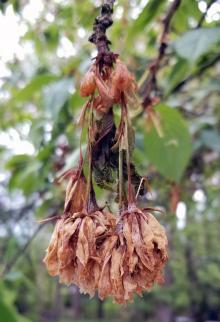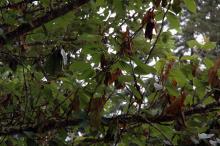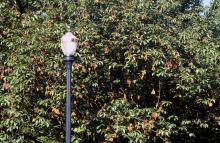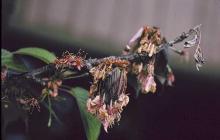See:
Cherry (Prunus spp.) - Brown Rot Blossom Blight and Fruit Rot
Cause The fungi Monilinia fructicola and M. laxa can incite a blossom blight, a twig and branch dieback, and a fruit rot of several Prunus spp. including many ornamental and fruit trees. Fungi survive year to year on infected twigs, branches, or old flower parts. Conidia are produced on infected plant debris in the tree when the temperature is above 40°F. Wind and rain blow spores (conidia and ascospores) to healthy blossoms in spring to begin the infection process during wet weather. Infection does not occur below 50°F and will occur for M. laxa above 55°F. Flowers can be blighted any time floral tissue is exposed but are most susceptible at full bloom. More spores can be produced on this tissue, initiating several more disease cycles during the spring. Under severe conditions, non-flowering shoots or leaves can be infected directly. High nitrogen fertilization also is associated with increased levels of brown rot.
Nurseries have reported problems with cultivars that flower outside of the main bloom period from the bulk of their Prunus, especially those that flower very early. Susceptible cultivars that they find difficult to treat include Prunus subhirtella 'autumnalis', Pendula Plena Rosea, and Snofazam. Cultivars that seem resistant include P. sargentii 'Columnar', P. serrulata 'Mt. Fugi', and P. x yedoensis 'Akebono'. Both fruiting and ornamental cherries, peaches, nectarines, prunes, plums, almonds, and apricots are susceptible. The disease is more of a problem west of the Cascade Range.
Symptoms Infected flower parts turn light brown and may develop areas of buff-color (M. fructicola) or gray (M. laxa) spores. Infected petals may look water soaked, which can be mistaken for frost injury. Flowers generally collapse as the fungus invades through the pedicel. Infected flowers often adhere to twigs and spurs through harvest or even winter. Depending on the fungus and plant infected, the disease may continue into twigs or spurs. Lesions may remain discrete or girdle the twig, causing all distal portions to die. Again, buff or gray spores (in sporodochia) may develop on these necrotic twigs.
Cultural control These must be supplemented by chemical methods especially in the wettest areas such as west of the Cascade Range.
- Remove and destroy infected twigs and branches in summer.
- Shorten large trees and prune out shaded limbs in summer for a more open canopy that dries out quickly.
- Use moderate amounts of nitrogen fertilizer.
Chemical control Only one (1) or two (2) applications during bloom are needed most years. Alternate or tank-mix products from different groups that have different modes of action. Limit the use of any one group during crop production.
- Banner MAXX at 2 to 4 fl oz/100 gal water. For non-bearing fruit trees only. Group 3 fungicide. 12-hr reentry.
- Bonide Fung-onil Multi-purpose Fungicide at 2.25 teaspoons/gal water. Group M5 fungicide. H
- Broadform at 4 to 6 fl oz/100 gal water. For non-bearing fruit trees only. Group 7 + 11 fungicide. 12-hr reentry.
- Chipco 26019 FLO at 1 to 2.5 quarts/100 gal water. Group 2 fungicide. 12-hr reentry.
- Compass 50 WDG at 2 to 3 oz/100 gal water. Do not use organosilicate additives. Group 11 fungicide. 12-hr reentry.
- Daconil Weather Stik at 1.38 pints/100 gal water. Treated fruit must not be eaten. Group M5 fungicide. 12-hr reentry.
- Decree 50 WDG at 0.75 to 1.5 lb/100 gal water. Group 17 fungicide. 12-hr reentry.
- Mural at 3.5 oz/100 gal water. Can be phytotoxic to certain apple and cherry cultivars. Do not apply to Yoshina variety. Group 7 + 11 fungicide. 12-hr reentery.
- Pageant at 12 oz/100 gal water. For non-bearing fruit trees only. Do not use with organosilicone-based adjuvants. Group 7 + 11 fungicide. 12-hr reentry.
- Spectracide Immunox Multi-Purpose Fungicide Spray Concentrate for Gardens at 1 fl oz/gal water. Group 3 fungicide. H
- Thiophanate-methyl-based products. Group 1 fungicides. 12-hr reentry.
- Cleary's 3336 EG at 12 to 16 oz/100 gal water. Do not use after fruit set if applied to fruiting trees.
- OHP 6672 4.5 F at 10.75 to 20 fl oz/100 gal water. Do not use treated fruit for food.
Reference Pscheidt, J.W., and Byther, R.S. 2001. Prunus Diseases p 317-325 in Diseases of Woody Ornamentals and Trees in Nurseries, R. Jones., and M. Benson (ed.). St. Paul, MN: APS Press.





